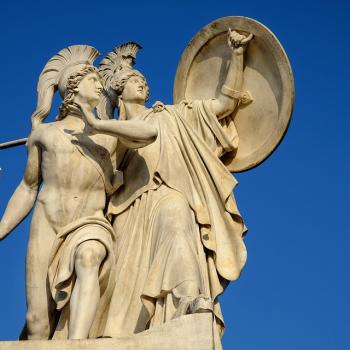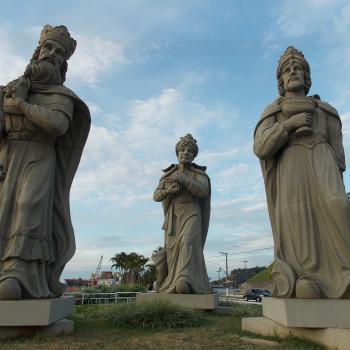To be a Christian in the Traditional sense means to be Trinitarian. They have always gone together. We have not always had the language we use to describe ourselves as Trinitarian. The word “Trinity” (trinitas) was probably coined by a north African thinker by the name of Tertullian, who was born around A.D. 160. He didn’t “invent” the idea; he simply found a word that was trying to express what the Church had already been teaching and practicing. That is, he came up with a word that expressed the peculiar practices and beliefs of the followers of Jesus Christ, who adamantly believed in One God, yet simultaneously worshiped the Father, the Son, and the Holy Spirit. Explain that!
We cannot. We recognize that we believe a mystery, a paradox, a conundrum. One God. Absolutely, we are monotheists. Yet Father, Son, and Holy Spirit. Three. But One.
And so we struggle to understand. As we should. Not that we are aiming for the Aha! moment that means we finally “get it.” We struggle to understand because in the struggle we encounter the Great God we worship, who never ceases to reveal himself to us and bid us come, enjoy his Presence, immerse ourselves in the inexpressible wonder of who he is.
When Jacob encountered the angel there on the shores of Jabbok river (Gen. 32.22-32), the angel seemed downright delighted that Jacob would wrestle with him, cling to him and not let him go without a blessing. Maybe that’s a little like our work with the Trinity. We wrestle, but we don’t prevail. Like Jacob, we want to know who this God is, but the angel won’t tell Jacob his name. We may think, too, of Samson’s father, who also had an encounter with an angel (Judg. 13:1-25). Samson’s mother called the angel “very awesome.” Samson’s father begged him, “What is your name?” And to him, the angel gave this beautiful reply: “Why do you ask my name, since it is wonderful.” (Some translations: It is beyond understanding or It is a name of wonder.)
Meanwhile, back down here on earth, we poke around in the “structures of linguistic coherence.” One of the first modern attempts to work with the Trinity can be called an engagement with discontinuity. This trajectory (as Anatolios calls it) builds on the inability of language and doctrine to really say anything intelligible about God’s real essence. There is a completely solid curtain that lies between our talk about God and the reality of God as he is in himself. All we can really talk about is how we experience God. When we talk about Son and Spirit, we are talking about the ways God has interacted with the world, and so we limit our conversation about God to what is called “salvation history”—the story of God’s work in the world, from creation through culmination.
There are some advantages to this method, to be sure. For one, we are a people of the book, a people with historical ties. We are not mythologists, despite Joseph Campbell’s nattering. We believe that God has really, actually engaged in human history, acted within space and time, even to the point of entering into it himself in the person of Jesus. So, when we limit ourselves to talking about the Trinity as we experience Trinitarian action, instead of trying to get all ethereal and talk about God’s inner workings, we are on solid ground.
(An academic aside: Anatolios associates this approach most popularly with Friedrich Schleiermacher, an 18th-century German theologian. It has been adopted by my ‘friend,’ Catherine LaCugna, whose God for Us came out in 1991. Despite Anatolios’ critique of LaCugna, I heartily recommend her book, at least as a foray into the relational aspects of the Trinity with the human soul.)
Anatolios points out the problem with this approach when he explains that such thinking puts us in an essential, and ultimately untenable, bind. We want to say that the Gospel is God’s true revelation of himself and that Jesus is God’s image, but then we turn around and say, well, it isn’t really a self-communication…only a “rescue operation.” We are ultimately saying we don’t know anything true about who he really is, only that he is the kind of God who does such things. We want to talk about God as “being in communion”—a God of relationship—but we have to reject the understanding that God is, in his own being, relational, a Trinity. We know what face he shows us, but who is behind that face? Nothing we can know, according to this approach. Anatolios quotes LaCugna, who expresses this: “The doctrine of the Trinity is not ultimately a teaching about ‘God’ but a teaching about God’s life with us and our life with each other” (italics in original).
But doesn’t God want us to know him and worship him in spirit and in truth? Or is it really all about us? That is where this approach leaves us, with ourselves as the center and defining reality of all that we can know about God. God, in approach #1, is not only mystery, but completely unrevealed.
Authentic Trinitarian spirituality focuses on God revealing his true self in love and glory. Anything less, anything that makes salvation history primarily about our experiences, is dangerously close to spiritual navel gazing.
Next up, modern approach #2.
___________________________
Note to Reader: This series on Trinitarian Spirituality explores the history and spirituality behind the shaping of the Nicene Creed using Khaled Anatolios’ Retrieving Nicaea: The Development and Meaning of Trinitarian Doctrine (Grand Rapids, MI: Baker Academic, 2011) as guide and inspiration. It’s best to begin at the beginning: An Introduction.












